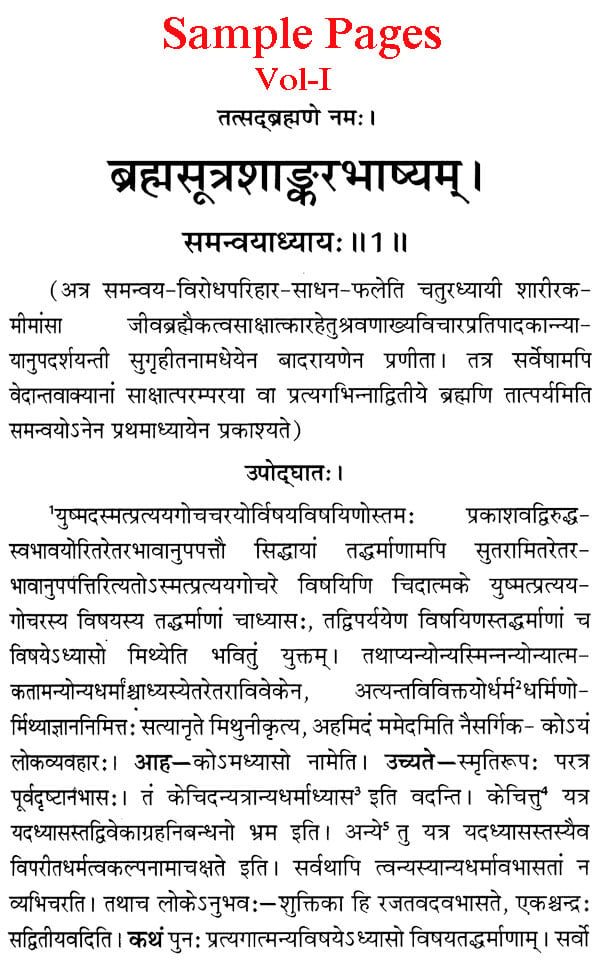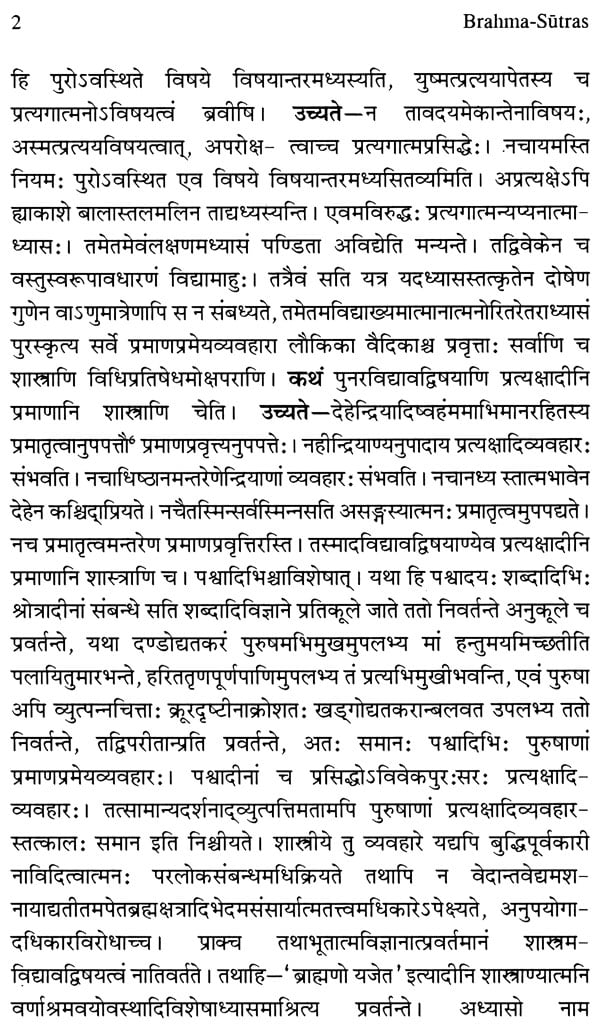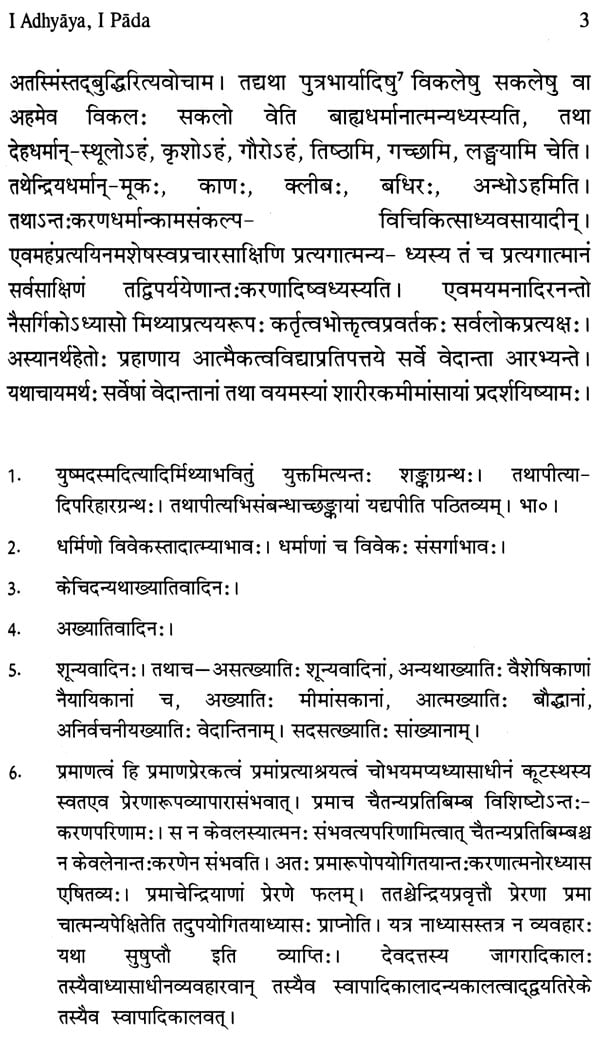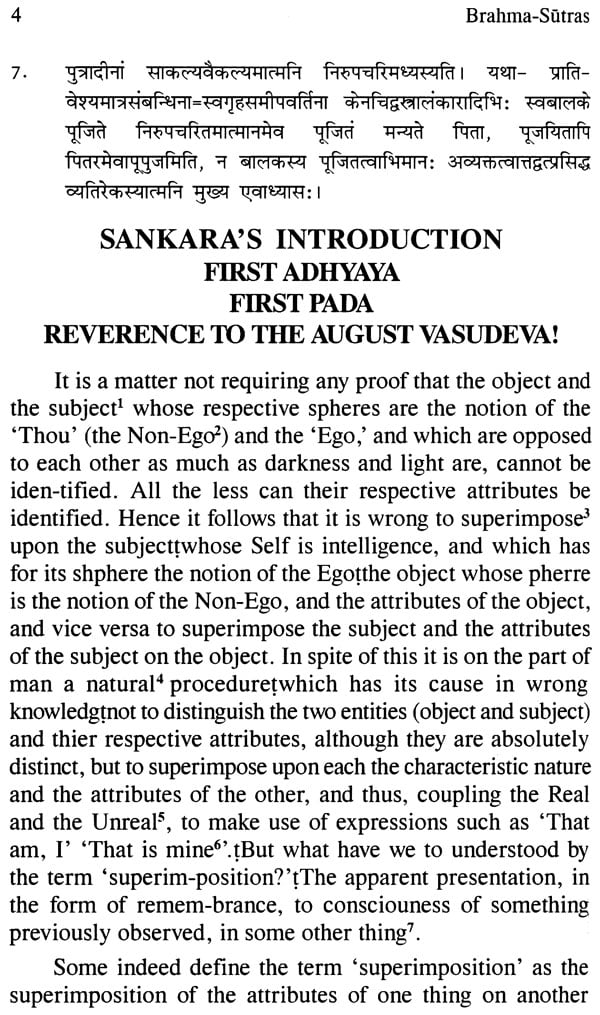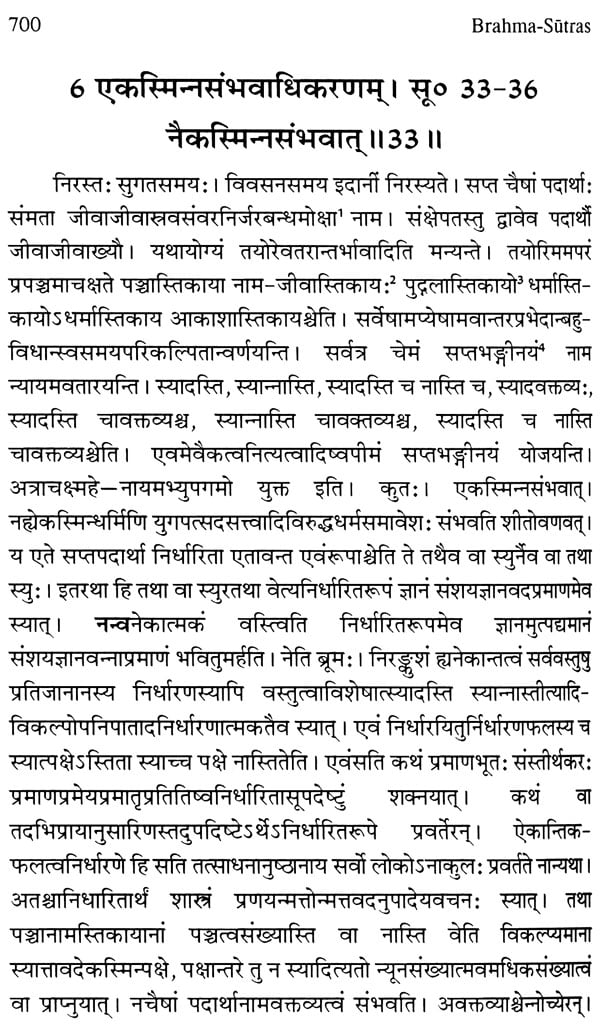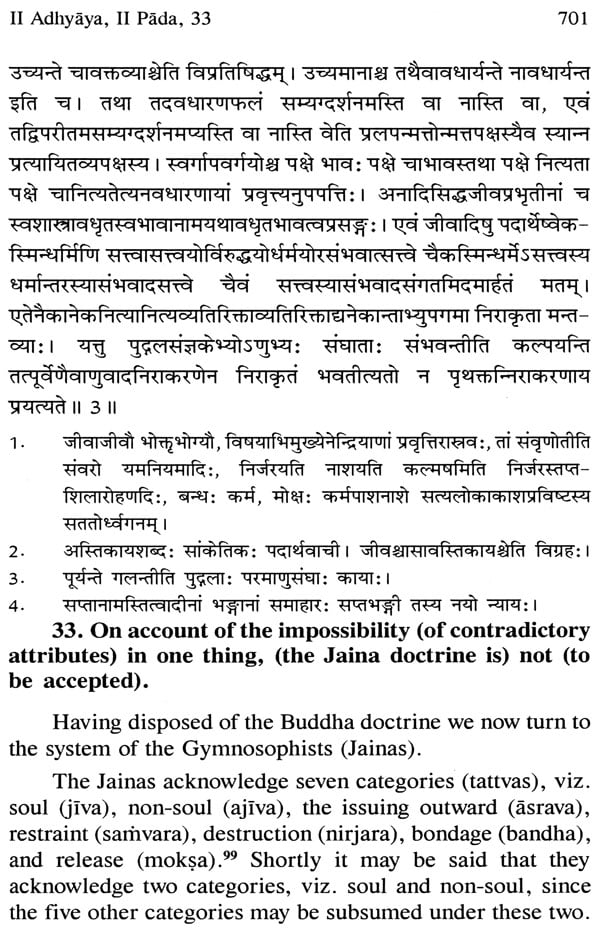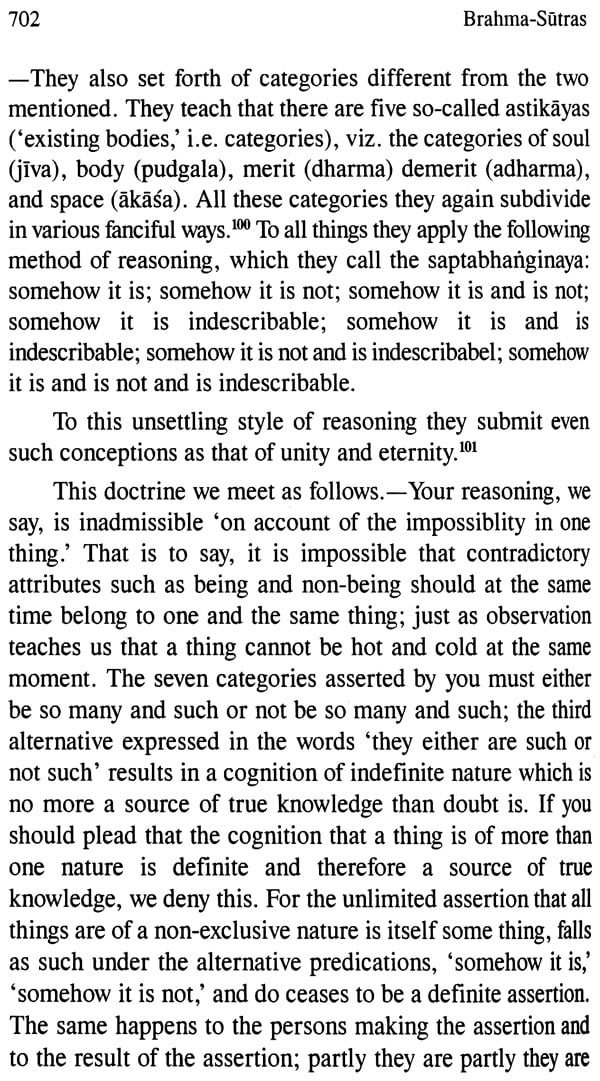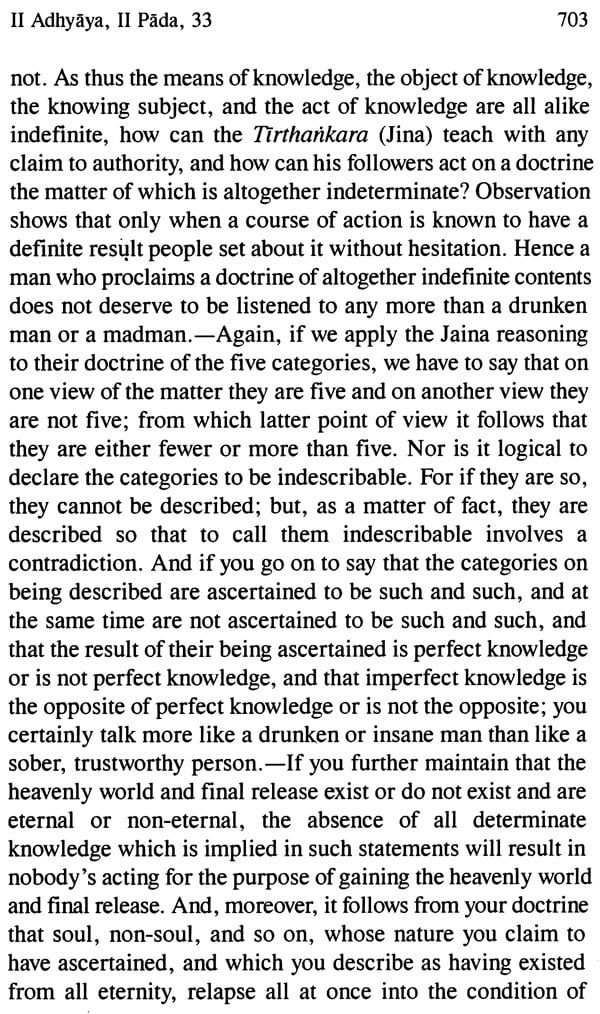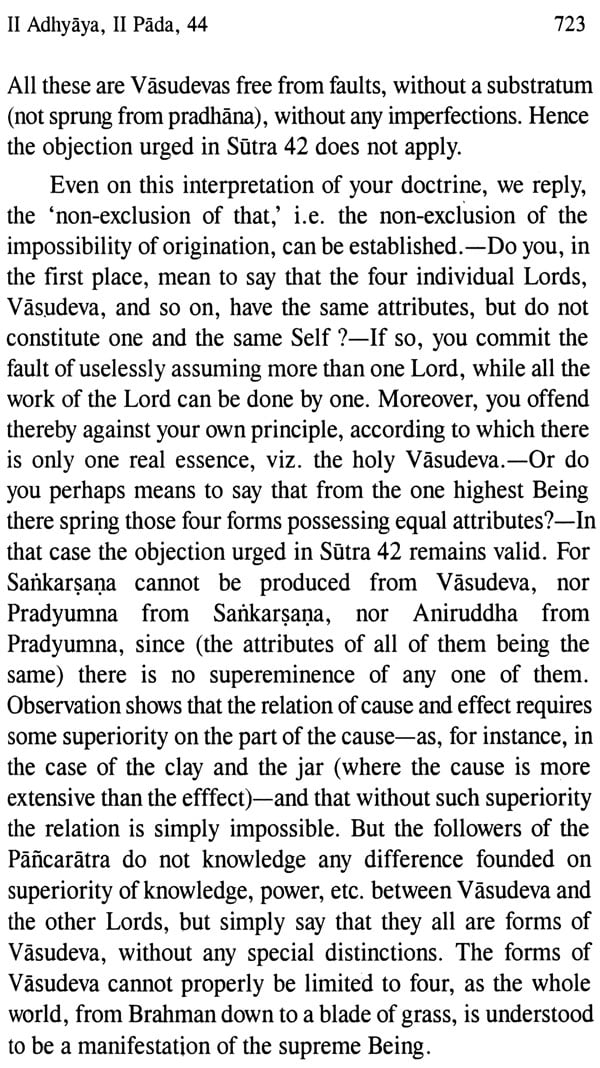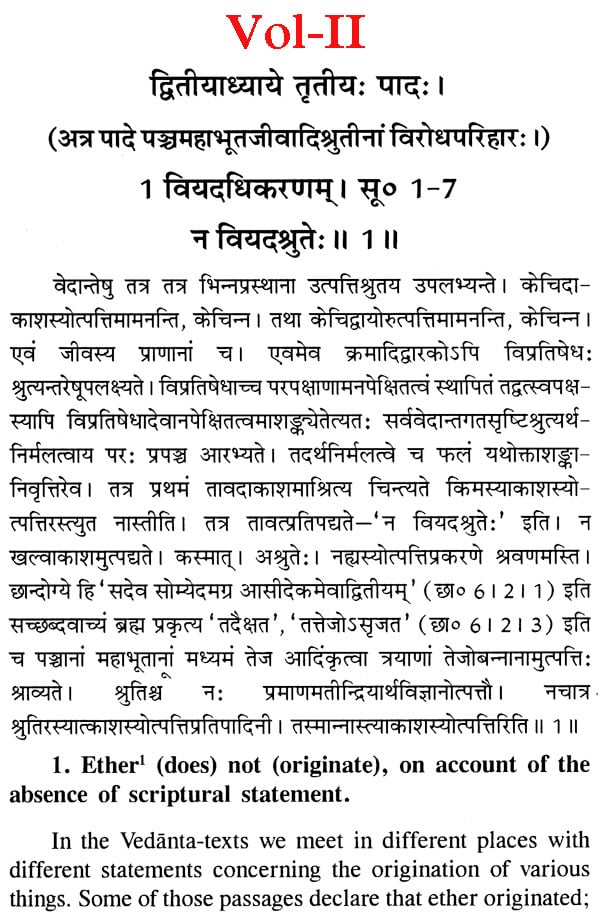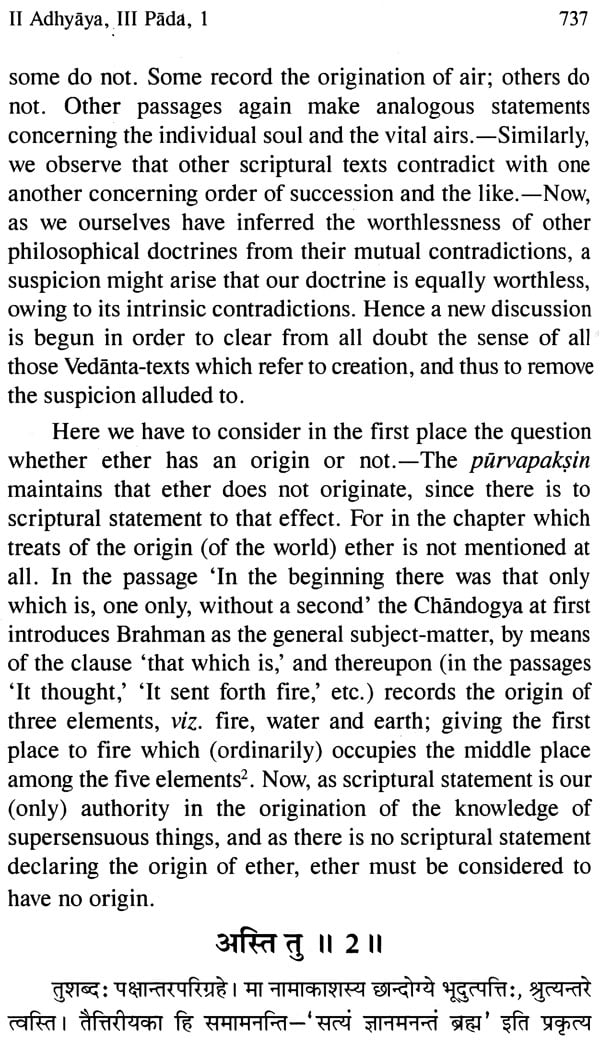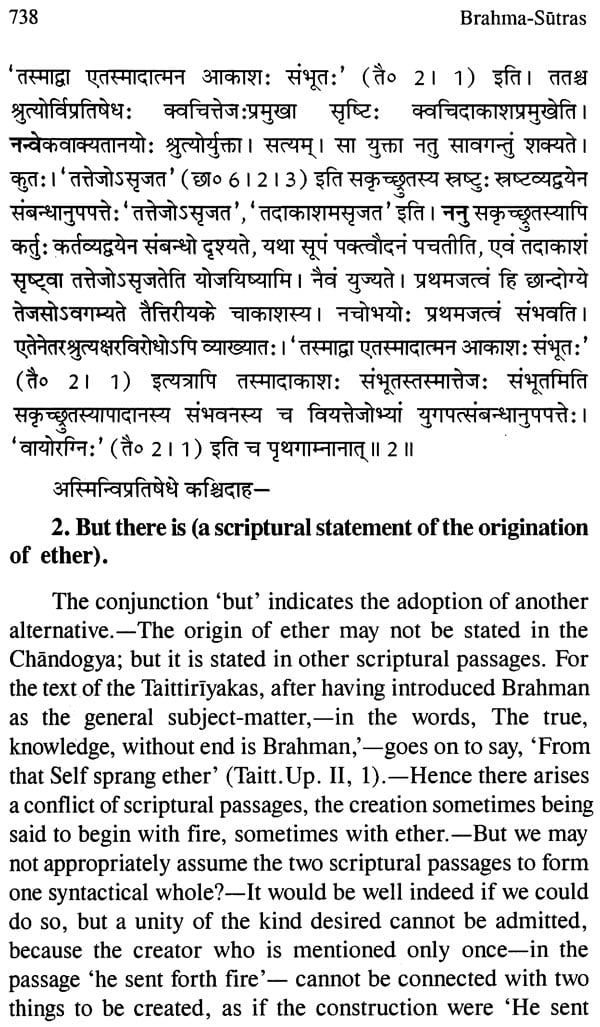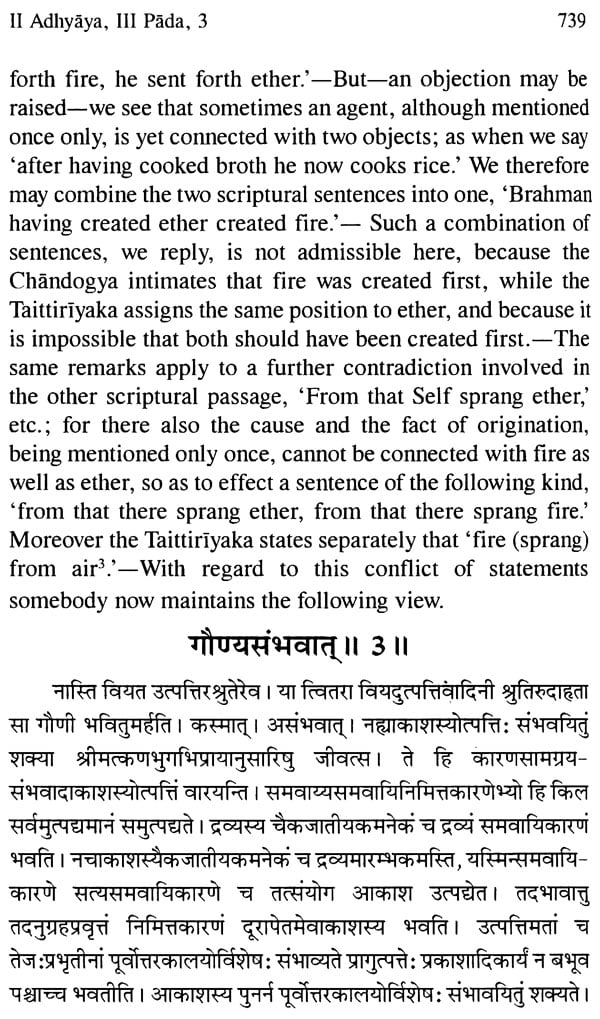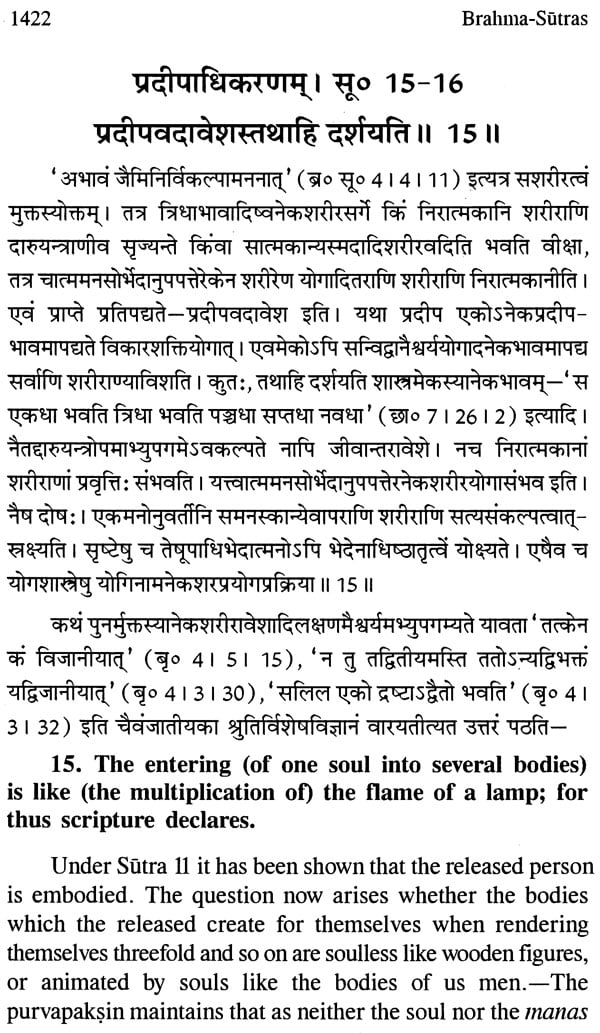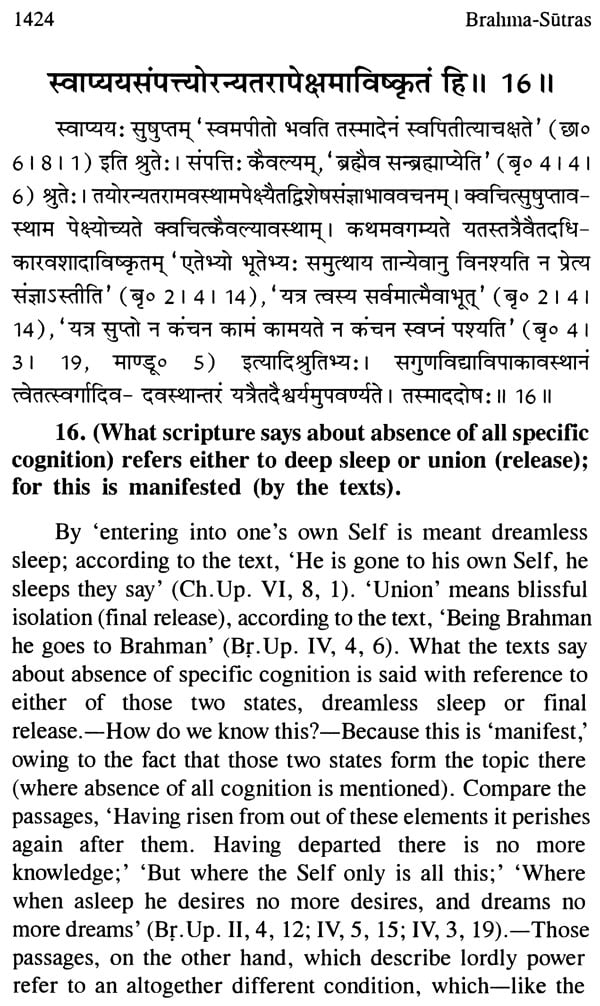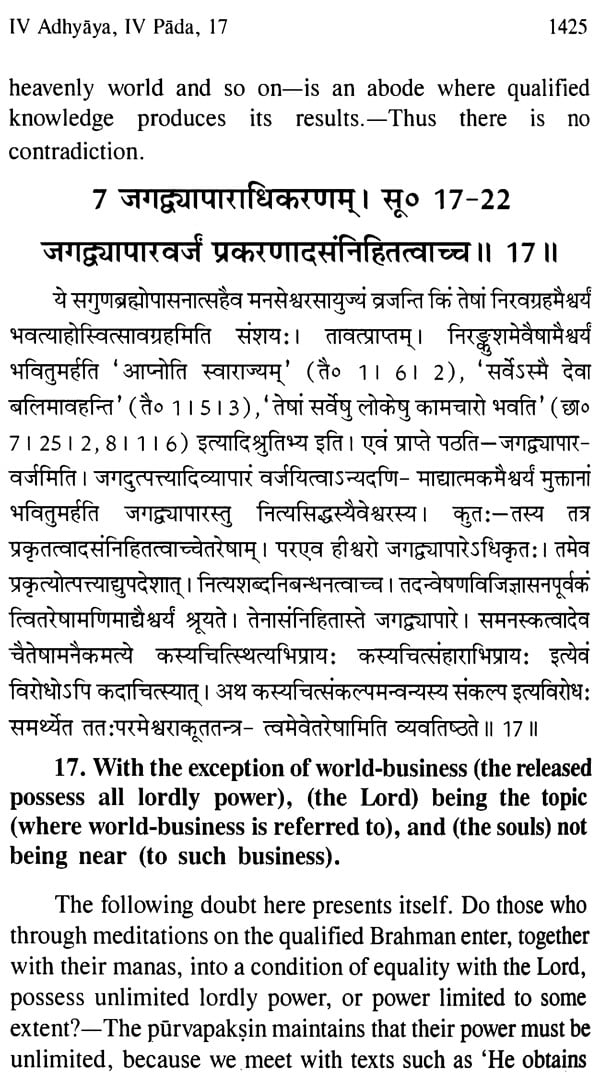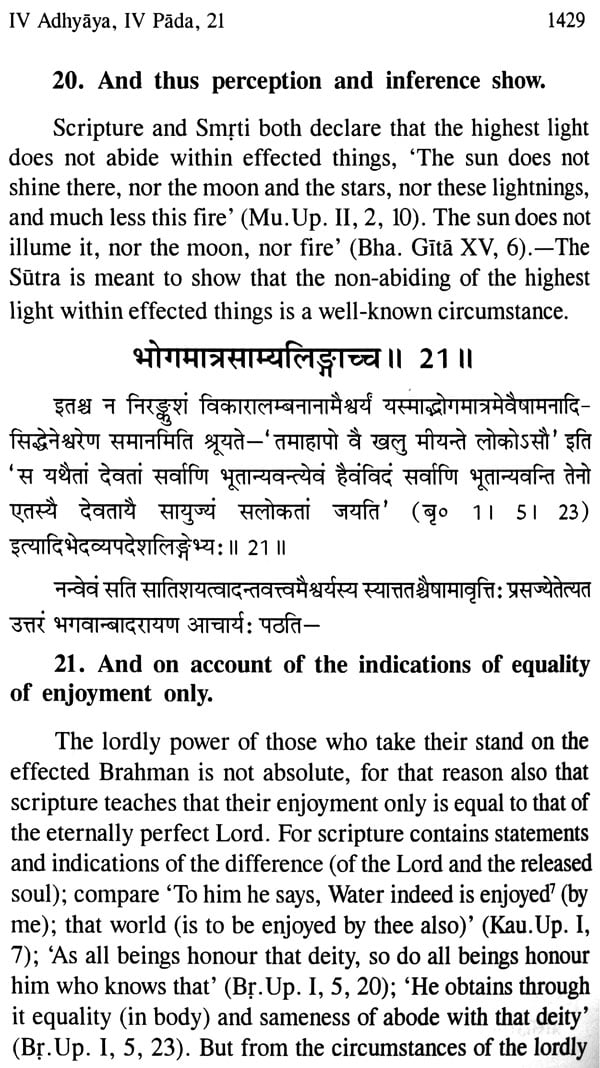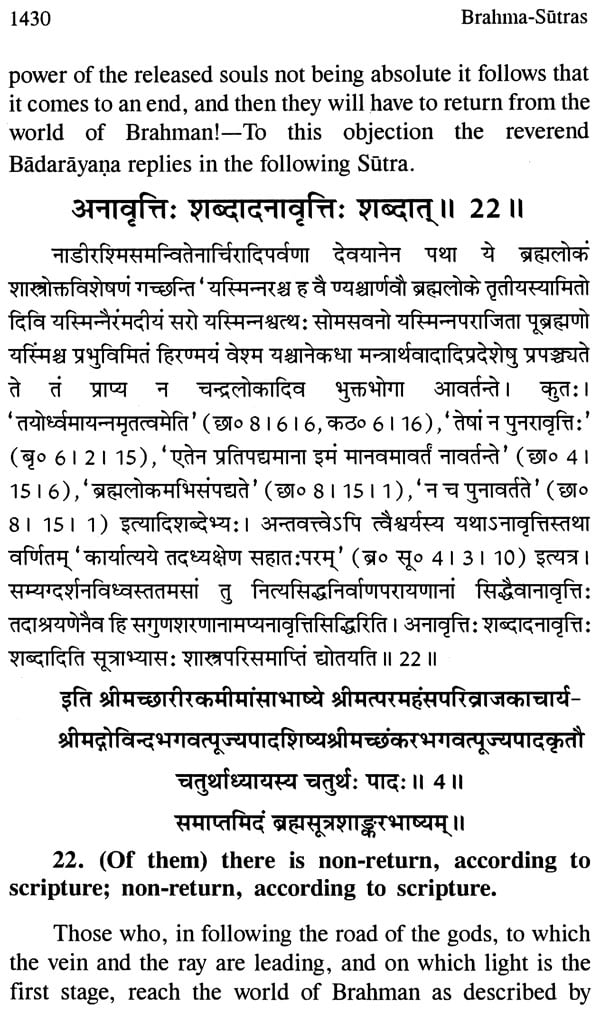
Brahma - Sutras in Two Volumes (Sanskrit Text with The Commentary of Acarya Sankara, English Translation and Notes)
Book Specification
| Item Code: | NAO398 |
| Author: | George Thibaut and Dr. Narasingha Charan Panda |
| Publisher: | Bharatiya Kala Prakashan |
| Language: | Sanskrit Text with English Translation |
| Edition: | 2018 |
| ISBN: | 9788180903434 |
| Pages: | 1456 |
| Cover: | Hardcover |
| Other Details | 8.5 inch X 5.5 inch |
| Weight | 1.90 gm |
Book Description
In the canon of Vedanta literature, the Brahma Sutra occupies a unique position. The Brahma Sutras attempt to reconcile the seemingly contradictory and diverse statements of the various Upanisads and the Bhagavad Gita, by placing each teaching in a doctrinal context. The word "Sutra" means "thread", and the Brahma Sutras literally stitch together, the various Vedantic Philosophical teachings into a logical, systematic, as well as traditional manner. Of commentaries on the Brahma Sutra, Sankara's commentary stands pre-eminent in elaborating Advaita Vedanta according to his tradition.
The Brahma Sutra consists of 555 aphorisms or Sutras, in four chapters, each chapter being divided into four sections each. The first chapter explains that all the Vedantic texts talk of Brahman, the Ultimate Reality, which is the goal of life. The second chapter discusses and refutes the possible objections against Vedanta philosophy. The third chapter rightly elaborates the process by which Ultimate Emancipation can be achieved. The fourth chapter clearly discusses the state that is achieved in Final Emancipation.
This book contains the original Sanskrit text with Acarya Sankara's Sanskrit commentary as well as revised English translation for the benefit of common readers of Sanskrit in general & the researchers of Indology in particular. However, this book would be immensely useful to the students as well as researchers to clearly know and understand about Acarya Sankara's Advaita Vedanta Philosophy in a positive direction.
Dr. Narasingha Charan Panda (Dr. N.C. Panda), ICCR Chair Visiting Professor of Sanskrit, Sanskrit Studies Center, Silpakorn University, Bangkok, Thailand, (basically from Vishveshvaranand Vishvabandhu Institute of Sanskrit and Indological Studies, Panjab University (Chandigarh), Sadhu Ashram, Hoshiarpur) is well-known in the field of Indological Research, who combines in him a comprehensive understanding of scholarly issues, impartial judgment and an exemplary clarity of expression. Besides, Dr. Panda is being associated with a number of Research Journals in the capacity of Advisor as well as Editor in India & Abroad.
Presently, as the Visiting Professor of Sanskrit, Dr. Panda is the Editor of the International Indological Journal of Sanskrit Studies Centre, Silpakorn University, and Bangkok, Thailand. As an ardent scholar & a successful researcher of Indo logy, he has contributed more than 100 learned Research papers, attended more than 75 Seminars & Conferences & has written & edited a number of valuable Books (more than 21 Books) with ISBN Nos.
The Brahma Sutras attempt to reconcile the seemingly contradictory and diverse statements of the various Upanisads and the Bhagavad Gita, by placing each teaching in a doctrinal context. The word "sutra" means "thread", and the Brahma Sutras literally stitch together the various Vedanta teachings into a logical and self-consistent whole. However, the Brahma Sutras are so terse that not only are they capable of being interpreted in multiple ways, but they are often incomprehensible without the aid of the various commentaries handed down in the main schools of Vedanta thought. The Vedanta-Sutras supply ample evidence that at a very early time, i.e. a period before their own final composition, there were differences of opinion among the various interpreters of the Vedanta. These sutras systematize the Jnana-kanda (path of wisdom, as opposed to Karma-kanda, the path of action) of the Veda, by combining the two tasks of concisely stating the teaching of the Veda and argumentatively establishing the specific interpretation of the Veda adopted in the sutras. The sutras also discuss the role of karma and God and critically address the various doctrines associated with Buddhism, Jainism, Yoga, Nyaya, Vaisesika, Saiva, Sakta, Atheism, and Samkhya Philosophies of India.
In the canon of Vedanta literature, the Brahma Sutra occupies a unique position as the oldest systematic commentary on the Upanisads. It defines the thread of Life Force (prana) by which all of the universal objects are bound together. The Brahma Sutras also constitute the Nyaya-prasthana, the logical starting point of the Vedanta philosophy (Nyaya = logic/order). No study of Vedanta is considered complete without a close examination of the Prasthana-Traya, the texts that stand as the three starting points. While the Upanisads (Sruti-prasthana, the starting point of revelation) and the Bhagavad- Gita (Smrti-prasthanay. the starting point of remembered tradition) are the basic source texts of Vedanta, it is in the Brahma Sutras that the teachings of Vedanta are set forth in a systematic and logical order.
Acarya Sankara is one of the greatest philosophers, India has ever produced and also the greatest exponent of Advaita philosophy. He is worshipped as an incarnation of Lord Siva. Acarya Sankara's vision of India regarding Hindu philosophy is unique and outstanding. His works in Sanskrit establish the doctrine of Advaita, the unity of the Atman and Nirguna Brahman"Brahman without attributes". His works elaborate on ideas found in the Upanisads. He wrote copious commentaries on the Vedic canon (Brahma Sutras, Principal Upanisads and Bhagavad Gita) in support of his thesis. The main opponent in his work is the Mimamsa School of thought, though he also offers arguments against the views of some other schools like Samkhya and certain schools of Buddhism.
This book contains the original Sanskrit text with Acarya Sankara's Sanskrit commentary as well as revised English translation for the benefit of common readers of Sanskrit in general, and the researchers of Indo logy in particular. Besides, this work also contains glossary as well as bibliography. However, this book would be immensely useful to the students as well as researchers to know and understand the Acarya Sankara's Advaita Vedanta Philosophy in a positive direction.
I have dedicated this work to my lovely parents late Pundit Dinabandhu Panda and Smt. Kamalini Panda. Due to their kind blessings I got every success in life. I would like to specially mention here that I have learned Sanskrit in my childhood days due to the noble teachings of my father, who used to be a Pundit in a Sanskrit College in Bhadrak, Odisha. Besides, on this occasion, I am also remembering my great Sanskrit teachers as well as well wishers and even extending my thankfulness to them for their great support and blessings.
I offer my most sincere thanks to my wife Mrs. Shradhanjali Panda and my lovely daughter Prajna for their co-operation in accomplishing this work in time.
I am extending my sincere thanks to my colleagues of Sanskrit Studies Centre of Silpakorn University, Bangkok, for their positive advices & other academic help.
Shri C.P.Gautam, publisher, Bharatiya Kaka Prakashan, Delhi, deserves special mention here. Due to his personal interest and sincere effort, the book has been brought out in time and also in beautiful form. Lastly, I owe an enormous debt of gratitude to all those scholars, Institutions and Publishers, whose works/editions have helped me a lot in preparing this book.
The word Vedanta literally means 'the end of the Vedas'. Primarily, the word understood for the Upanisads, though afterwards its denotation widened to include all thoughts developed out of the Upanisads, The Upanisads may be regarded as the end of the Vedas in different senses, firstly, the Upanisads were the last literary products of the Vedic period. Three kinds of literature of this period can be broadly classified: the earliest being the Vedic mantras, the next being the Brahmanas, which guiding and encouraging the Vedic rituals and the last, the Upanisads, which clearly discuss the philosophical tattvas or matters in a comprehensive way. In a broad sense these were called the Srutis or Vedas. Secondly, in respect of study also, the Upanishads come last. As a rule, a man should study the Vedic Samhitas first, with the help of Brahmanas and Vedangas. But finally, he should read the Upanisads, as these texts help him to understand the real meaning of life and the life after death. These spiritual texts teach the man the mystery of life as well as the universe in a right way. Thirdly, the Upanisads may be regarded as the end of the Veda, also in the sense that they mark the culmination of the Vedic speculation. Generally, the word Upanisads means , what destroys the ignorance and gets man near or closer to the God,' or 'what gets the man near to the teacher'. However, the Upanisads were regarded as the inner or secret meanings of the Vedas; hence, their teachings were sometimes called Vedopanisad or the mystery of the Vedas (Taittiriya Upanisad, I.11).
Hence, Vedanta or Uttara-Mimamsa is the standard and the characteristic Philosophy of India. It is based on the oldest spiritual intuitions of the Upanisads, developed, systematized and updated by an unbroken tradition of great sages and Acharyas. Though the name of Vedanta does not occur in the old Upanisads, we can hardly doubt that it was the Vedantic thoughts, contained in the Upanisads, which gave the first impulse to more systematic philosophical speculations in India. Several scholars have tried to prove that Samkhya ideas prevailed in India at an earlier time than the Vedantatic ideas. But tough there certainly are germs of Samkhya theory is in the Upanisads, they are but few and far between while the strictly Vedantic concepts meet us at every step in the hymns, the Brahmanas, the Aranyakas and in the Sutras. Vedanta is clearly the native philosophy of India. It is true that this philosophy is not yet treated systematically in the Upanisads, but neither is the Samkhya. To us, who care only for the growth of philosophical thought on the ancient soil of India, Vedanta is clearly the first growth; and the question whether Kapila lived before Badarayana, or whether the systematic treatment of the Samkhya took place before that of Vedanta can hardly arise.
However, there is no doubt that the Upanisads are the abstract of all Vedas & it contains the mystery of all sacred knowledge, which may help a man to get the liberation. In fact, the Upanisads were many in number and developed in the different Vedic Schools at different times and places. The problems discussed and solutions offered presented differences in spite of a unity of general outlook. The need was felt, therefore, in course time for systematizing the different teachings so as to bring out the harmony underlying them. Badarayana's Brahma-Sutras or Sariraka-Sutras or Vedanta-Sutras or Uttar Mimamsa, undertakes this task.
The Brahma Sutras attempt to reconcile the seemingly contradictory and diverse statements of the various Upanisads and the Bhagavad Gita, by placing each teaching in a doctrinal context. The word "sutra" means "thread", and the Brahma Sutras literally stitch together the various Vedanta teachings into a logical and self-consistent whole. However, the Brahma Sutras are so terse that not only are they capable of being interpreted in multiple ways, but they are often incomprehensible without the aid of the various commentaries handed down in the main schools of Vedanta thought. The Vedanta-Sutras supply ample evidence that at a very early time, i.e. a period before their own final composition, there were differences of opinion among the various interpreters of the Vedanta. These sutras systematize the Jnana-kanda (path of wisdom, as opposed to Karma-kanda, the path of action) of the Veda, by combining the two tasks of concisely stating the teaching of the Veda and argumentatively establishing the specific interpretation of the Veda adopted in the sutras. The sutras also discuss the role of karma and God and critically address the various doctrines associated with Buddhism, Jainism, Yoga, Nyaya, Vaisesika, Saiva, Sakta, Atheism, and Samkhya Philosophies.
In the canon of Vedanta literature, the Brahma Sutra occupies a unique position as the oldest systematic commentary on the Upanisads. It defines the thread of Life Force (prana) by which all of the universal objects are bound together. The Brahma Sutras also constitute the Nyaya-prasthana, the logical starting point of the Vedanta philosophy (Nyaya = logic/order). No study of Vedanta is considered complete without a close examination of the Prasthana traya, the texts that stand as the three starting points. While the Upanisads (Sruti-prasthana, the starting point of revelation) and the Bhagavad- Gita (Smrti-prasthana), the starting point of remembered tradition) are the basic source texts of Vedanta, it is in the Brahma Sutras that the teachings of Vedanta are set forth in a systematic and logical order.
The Brahma Sutras consist of four Chapters (Adhyayas). Each Chapter (Adhyaya) is divided into four padas (parts) and each pada consists of single or several groups of Sutras called Adhikaranas. There are total 191 Adhikaranas containing 555 Sutras, (aphorisms) in the Brahma –Sutras
The First Chapter explains that all the Vedanta texts talk of Brahman, the Ultimate Reality, which is the goal of life. There are thirty-nine Adhikaranas and one hundred thirty-four Sutras in this Chapter. First pada contain eleven Adhikaranas with thirty-one Sutras, second pada contain seven Adhikaranas with thirty-two Sutras, third pada contain thirteen Adhikaranas with forty-three Sutras, and fourth pada contain eight Adhikaranas with twenty-eight Sutras.
The Second Chapter discusses and refutes the possible objections to Vedanta philosophy. There are forty-seven Adhikaranas and one hundred fifty-seven Sutras in this Adhyaya. First pada contain thirteen Adhikaranas with thirty-seven Sutras, second pada contain eight Adhikaranas with forty-five Sutras, third pada contain seventeen Adhikaranas with fifty-three Sutras, and fourth pada contain nine Adhikaranas with twenty-two Sutras.
The Third Chapter describes the process by which Ultimate Emancipation can be achieved. There are sixty- seven Adhikaranas and one hundred eight-six Sutras in this Chapter. First pada contain six Adhikaranas with twenty-seven Sutras, second pada contain eight Adhikaranas with forty-one Sutras, third pada contain thirty-six Adhikaranas with sixty-six Sutras, and fourth pada contain seventeen Adhikaranas with fifty-two Sutras.
The Fourth Chapter elaborates the state that is achieved in Final Emancipation. There are thirty eight Adhikaranas and Seventy-eight Sutras in this Chapter. The first pada contain fourteen Adhikaranas with nineteen Sutras. The second pada contain eleven Adhikaranas with twenty-one Sutras. The Third pada contains. Six Adhikaranas with sixteen Sutras, The fourth pada contain seven Adhikaranas with twenty-two Sutras.
However, in short, it can be said that the First Chapter exclusively elaborates that all the Vedanta texts talk of Brahman, the Ultimate Reality, which is the goal of life. The very first Sutra offers an indication into the nature of the subject matter of Brahma Sutra (I.1.1 athato brahma jijnasa- Now: therefore the inquiry (into the Real Nature) of Brahman. The whole Brahma Sutra very clearly explains in detail the True Nature and Form of Brahman. Second Chapter discusses and refutes the possible objections to Vedanta Philosophy. Third Chapter specifies the process by which Ultimate Emancipation (moksa) can be achieved. Fourth Chapter talks of the state that is achieved in Final Liberation or moksa.
